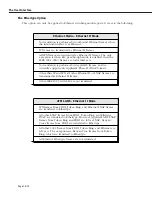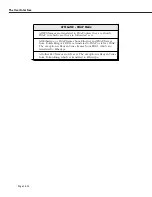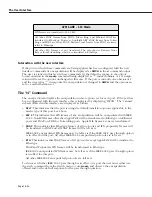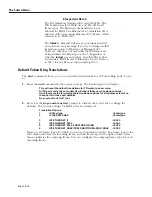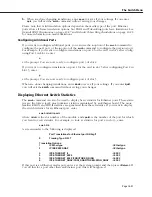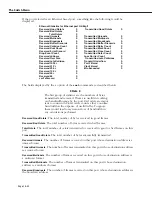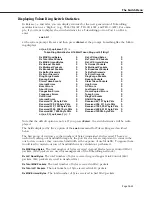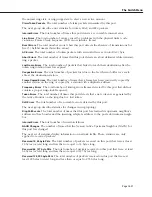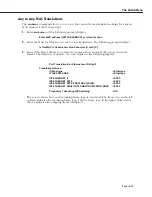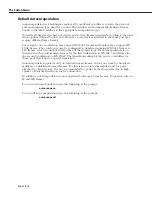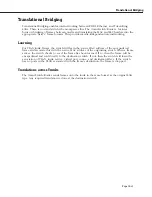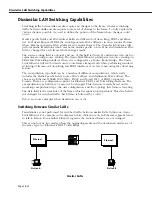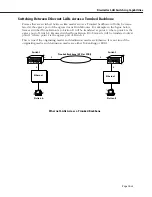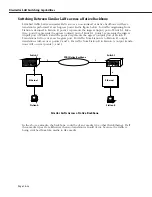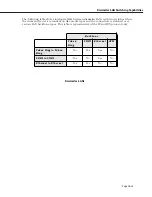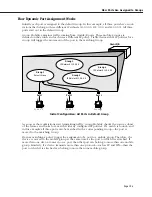
The Switch Menu
Page 18-34
Received Late Collision, Transmitted Late Collisions
. A late collision is a collision which occurs in
a frame when more than 64 bytes have been received/transmitted. On a correctly configured
network, which doesn't exceed physical limits of size, impedance, station spacing, etc.,
stations should always collide within 64 bytes due to propagation times. Late collisions indi-
cate that the network is violating such restrictions or some stations are having a problem
which prevents them correctly implementing the CSMA/CD protocol. For example, a station
with a faulty receiver can not “hear” transmissions in progress and so may fail to defer its
transmissions causing late collisions to be seen by other stations.
Received Jabbers, Received Over Size
. The maximum frame size on Ethernet is 1518 bytes.
Frames longer than this are illegal.When such a frame has a valid FCS it is counted as over-
size. If it has an FCS error then it is counted as a Jabber. The former is indicative of a device
with improper software, the latter of a device with some hardware fault on its transmitter. In
both cases the faulty station causes other devices, such as this port, to see these errors.
Drop Event Count
. When a frame is dropped, for example, frame reception is aborted because
of lack of buffers, there may be only one or there may be many frames so affected. In either
case there is a single occurrence of an “event” during which frames were lost. This is what
this statistic counts. This statistic is used in RMON as follows. For example, at network start
up there may be a huge amount of flooded traffic leading to much lost traffic. When a
network administrator subsequently looks at the statistics they might see 2 million frames
transmitted with 5000 frames lost. At that point they have no clue as to when and why those
5000 frames were lost. If drop event is 5000 it may indicate an intermittent problem where
single frames are being lost. If drop event is 5 or 6 it might indicate a few events when large
numbers of frames were lost such as in our example, the network restart.
Received 1024 +, Received 512 +, Received 256 +, Received 128 +, Received 65 +, and Received 64
.
These count the number of frames in the indicated frame sizes:
Received 64
counts 64 byte
frames,
Received 65+
counts frames between 65 and 127 inclusive,
Received 128+
counts
between 128 and 255, etc. These statistics are only applied to received frames.
♦
Note
♦
The
Received 1024 +
,
Received 512 +
,
Received 256 +
,
Received 128 +
,
Received 65 +
, and
Received 64
fields
will always display zero for Gigabit ports.
Port Filtered
. On shared media ports, Station A transmitting to Station B will be directly deliv-
ered. Therefore, the frame received by this port just needs to be dropped. This action is
referred to as filtering and this counts the number of frames so filtered.
Vlan Filtered
. The Omni Switch/Router restricts traffic above the normal Level 2 filtering by
applying VLAN rules. Frames which are dropped because of VLAN rules are counted here.
Mtu Exceeded
. This statistic is not currently supported and is always zero.
Summary of Contents for Omni Switch/Router
Page 1: ...Part No 060166 10 Rev C March 2005 Omni Switch Router User Manual Release 4 5 www alcatel com ...
Page 4: ...page iv ...
Page 110: ...WAN Modules Page 3 40 ...
Page 156: ...UI Table Filtering Using Search and Filter Commands Page 4 46 ...
Page 164: ...Using ZMODEM Page 5 8 ...
Page 186: ...Displaying and Setting the Swap State Page 6 22 ...
Page 202: ...Creating a New File System Page 7 16 ...
Page 270: ...Displaying Secure Access Entries in the MPM Log Page 10 14 ...
Page 430: ...OmniChannel Page 15 16 ...
Page 496: ...Configuring Source Route to Transparent Bridging Page 17 48 ...
Page 542: ...Dissimilar LAN Switching Capabilities Page 18 46 ...
Page 646: ...Application Example DHCP Policies Page 20 30 ...
Page 660: ...GMAP Page 21 14 ...
Page 710: ...Viewing the Virtual Interface of Multicast VLANs Page 23 16 ...
Page 722: ...Application Example 5 Page 24 12 ...
Page 788: ...Viewing UDP Relay Statistics Page 26 24 ...
Page 872: ...The WAN Port Software Menu Page 28 46 ...
Page 960: ...Deleting a PPP Entity Page 30 22 ...
Page 978: ...Displaying Link Status Page 31 18 ...
Page 988: ...Displaying ISDN Configuration Entry Status Page 32 10 ...
Page 1024: ...Backup Services Commands Page 34 14 ...
Page 1062: ...Diagnostic Test Cable Schematics Page 36 24 ...
Page 1072: ...Configuring a Switch with an MPX Page A 10 ...
Page 1086: ...Page B 14 ...
Page 1100: ...Page I 14 Index ...

